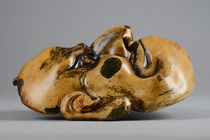Masque du théâtre "Nô", "ko beshimi" · Japon · ID: 3045059
Description
wood, gypsum, colour pigments, metal, engraved signature on the backside
Belonging to the category of “kishin” masks which were developed early in “nô” history and are used for portraying demons, goblins or other worldly creatures. This category is divided into two main parts, “tobide” and “beshimi”.
The “nô”-theatre evolved in the 14th century from the antique tradition of religious dances and burlesque plays, which used to be performed in temples. In the course of the time two independant forms developed: the severe “nô” drama and the humorous “kyogen” burlesque. The primary concern of the “nô” art is to convey “yûgen” to the audience, which means as much as “beauty”, “depth of sentiment”, “gracefulness”, “elegance”. It is essential to convey characters and events through minimal gestures and movements, but not to play in a realistic manner.
The “no” mask is called “no-men” or “omote” (= “face”). In the course of time about 250 different mask types for the depiction of different characters have been developed. There are masks for women and men, monsters and demons, as well as masks for divinities. In most cases they were carved from the wood of japanese cypress (“hinoki”). Traditional themes were taken from japanese mythology or literature.
Littérature comparée
Perzynski, Friedrich, Japanische Masken, Zweiter Band, Berlin, Leipzig 1925, p. 88, ill. b)






